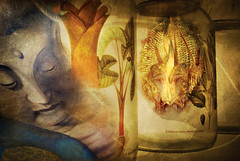 Image via WikipediaRecently I attended a wonderful wedding of two young friends that happened to be next door to the Quaker Retreat Center, Pender Hill, outside of Philadelphia. While I was unfamiliar with that name...I was familiar with the name Parker Palmer, who had spent many years there as student, teacher, and Dean.
Image via WikipediaRecently I attended a wonderful wedding of two young friends that happened to be next door to the Quaker Retreat Center, Pender Hill, outside of Philadelphia. While I was unfamiliar with that name...I was familiar with the name Parker Palmer, who had spent many years there as student, teacher, and Dean.Since the encounter with Pender Hill, I have been thinking more about Parker Palmer's work, which has always resonated with me.
I have also been reading a marvelous book by Mark Johnson--The Meaning of the Body: Aesthetics of Human Understanding--in which he comes back to Dewey's notion of the body-mind in fruitful and provocative ways.
So this morning Parker Palmer had and out of body experience with Mark Johnson and John Dewey--in my mind as I thought about the struggle individuals and groups have with interactions. Struggle is the problematic (a la Dewey). We always have situations that are unbalanced, poorly understood, present an issue that needs to be explored, inquired about--that's what Dewey's notion of situation has embedded in it. I was thinking about the issues of interactions as issues of power. This led me to the notion of balance (of power...power with) vs power that is out of balance (power over or power under; victimizer vs victimized). When one seeks power with, you are working from a position of confidence and capacity...you are power-ful. When one seeks power over or under, you are working from a position of fear. Power-ful is balanced, integrated, connected, calm. Power-less is unbalanced, disintegrating, dis-connected and fearful.
This brought me back to Mark Johnson and Dewey as I thought about the ways these stances are embodied and how our feelings or reactions provide us with important information about the ways others around us are engaged in negotiating power. I am so likely to think that I should discount physical information about how I am reacting or how I FEEL others are reacting, and yet this information is critical to understanding the structure and meaning of the power issues in an interaction.
I've set myself the personal task of learning more about Parker Palmer's Circles of Caring work as it applies to higher education. This seems like such a good fit with the notion of diversity in the workplace...in the largest sense of that term.
Thank you to all my distant teachers!












